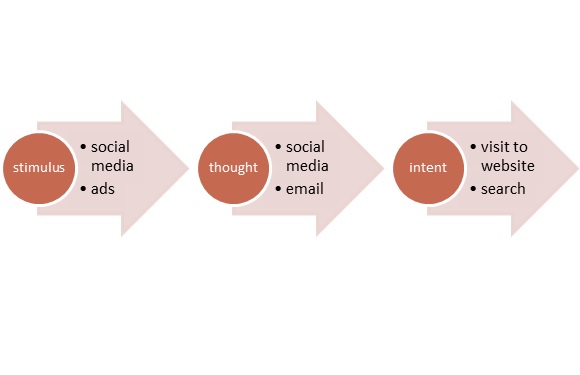Your cart is currently empty!

Your Customer’s Path to Purchase
Your customer’s path to purchase has been redefined with these basic steps:
- Stimulus: the moment when a potential customer becomes aware of your goods and services
- Zero moment of truth: the moment when a potential customer begins to research your goods and services online
- First moment of truth: the purchase itself, which may take place online or in a physical space
- Second moment of truth: the use of the goods or services
- Ultimate moment of truth: the decision to share or review your goods and services
In the CPG space, for example, the stimulus — the thing that makes people think about buying something — is likely to be a display ad or perhaps a pin at Pinterest. This is the “Oooh — cute shoes!” moment.
The part where the shopper considers the purchase is likely to involve an email communication from the company or some social media. For example, the shopper might ask friends at Facebook whether they’ve ever tried a product, or might look further in Pinterest or YouTube. They might respond to a sale or discount presented through remarketing.
The CPG purchase might take place at a website or in a brick and mortar store.
For healthcare, the path is different. Social media is more likely to be the stimulus. Search and website visits follow, with an appointment scheduled online or by phone.
What does this mean for marketing?
You need to meet your customer where she is along the path to purchase. Your ads should show up for your target market as stimulus. Your web site needs to show up in search as potential customers look for solutions to problems, or respond to stimulus as shoppers.
A shopper who’s looking for clothing or home decor products is very likely to look at Pinterest. She’s probably not scoping out veterinarians on Pinterest, though. However, she is very likely to search for health-related information there. If her local vet shows up for her at Pinterest, it will raise that vet in her estimation and cause her to visit the website of the practice. In other words, it’s likely to act as a stimulus for her to think about visiting that vet.
If she uses Google to research the issue that’s causing her to think about visiting a vet, and that vet’s website shows up in the search results, that increases the vet’s value and legitimacy for her. Multiple touchpoints increase the chances that she will choose that vet when she gets ready to make her purchase.
Are you meeting your customers where they are, when they’re interested in what you have to offer? That’s the key.
Show up along the customer path to purchase and your potential customer will be receptive to you when it’s time to buy.
by
Tags:
Comments
2 responses to “Your Customer’s Path to Purchase”
Great post on meeting customers during their buying journey! Google’s information on ZMOT is also a great resource on this topic and they have some great videos that we’ve found useful at allwebcafe when discussing the buying journey concept with clients.
For a lot of industries (especially those with longer buying journeys) the Intent process that involves search and website visits can offer a lot of insight about your audience when monitored and tracked correctly. And it seems the new Analytics features that have been rolling out lately are pushing to make that type of data easier to access.
Thanks again for the post and the Customer Journey tools!
Thanks, Alex! Google has found that people are likely to consult an average of 10 sources of information along that journey — fitting with the previous information that people need 5-12 contacts with a message to take action. What if your website turns up all along that path, with reviews, blog posts, social media, and white papers?

Leave a Reply